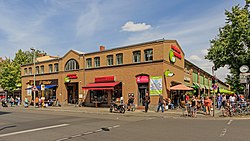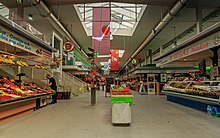Market hall XI
| Market hall XI Marheineke hall |
|
|---|---|
 The hall seen from the southwest, 2017 |
|
| Data | |
| place | Berlin-Kreuzberg |
| architect | Hermann Blankenstein , August Lindemann |
| Construction year | 1891/1892 |
| Floor space | 3,000 m² |
| Coordinates | 52 ° 29 '21.2 " N , 13 ° 23' 41.6" E |
The market hall XI , also called Marheineke-Halle after its location on Marheinekeplatz , is one of the former 14 urban market halls in Berlin , which were built in the then districts of Berlin at the end of the 19th century . They replaced the open markets in various urban squares and guaranteed better hygienic conditions. The market hall XI in Berlin-Kreuzberg was opened in 1892. At the end of the Second World War it was largely destroyed, after which it was only partially used. In the 1950s, the destroyed part was rebuilt in modern forms. Due to the fact that the structure of the building is largely not preserved in its original form, this building is not a listed building .
history
The closed market hall according to plans by the town planning officer Hermann Blankenstein with the assistance of the architect August Lindemann was built on Marheinekeplatz in Berlin-Kreuzberg . When it opened on March 15, 1892, it had a sales area of 2,808 square meters with 278 small market stalls for everyday goods .
During the First World War , from 1916 onwards, a soup kitchen was set up in the hall , in which around 15,000 Berliners received lunch every day. In the Second World War, the above-ground part of the hall was destroyed except for the western end building. However, storage rooms in the basement were retained. With the end of the war, 22 traders started selling urgently needed food in the basement. The other area was cleared and used as a depot for a rubble railway active in Kreuzberg until 1950 . In 1949 the market traders founded an interest group that took care of the complete reconstruction of the hall. In 1952, the city of Berlin commissioned the architect Paul Friedrich Nieß as the owner to draw up a design for a supplementary building adapted to the remainder of the building. The mayor of Kreuzberg, Willy Kressmann , finally laid the foundation stone for the reconstruction on February 26, 1953 and sank the documents of the multi-year paper war into the box.
In 1969 the Marheinekehalle was sold to a market hall management cooperative founded on June 11th, which has since been operated by Berliner Großmarkt GmbH (BGM).
In 1998 a comprehensive renovation took place. The market hall administration cooperative dissolved in 2003, so that BGM has been the owner of the property ever since.
This historic hall was redesigned in 2007 according to a completely new concept, the eastern area was fully glazed and reopened on December 1st of the same year. There were 50 individual stands for the trade in organic products , a specialty market with Italian, Greek, Spanish and Arab delicacies as well as regional specialties from the Uckermark and smaller catering areas. This is well received by residents from the area and numerous tourists.
Architecture details
The main body of the old hall consists of an iron support system that formed a central nave with a side aisle connected to the south and north . A skylight was inserted in the middle . On both sides there was a roofed entrance area, in the side walls of which terracotta decorations with stylized fruits, sea animals or flowers referred to the offers in the hall. In the Marheineke Hall, three medallions have been preserved in the head building. The walls are made of exposed bricks.
In the original state there was a dining and drinking hall, a medical station and other shops in the western end of the building. Inside was a kitchen, a porter's lodge and a storage room. In the eastern head building there was a police post and other shops. Toilets for men and women were arranged on the inner front wall. During the reconstruction, the skylight and the south aisle were omitted.
Current uses
There are mainly seasonal food offers from Berlin / Brandenburg in the hall every day. There is great customer interest in the products of the butcher and bakery trade as well as the dairies, vegetable farmers and flower growers from regional origins. The market hall concept also includes food stalls and high-quality restaurants. Small service providers such as locksmiths, shoemakers, copy shops and bookshops have established themselves in the side corridors. The operators describe their concept as a “balanced mix of tradition and innovation”. The northern structure of the hall is two-storeyed, on the gallery visitors can linger in the Kreuzberg art market , which attracts with changing exhibitions. For example, in March / April 2012 there was an exhibition with works by the artist Ralph Stabbert on the subject of the fish workshop fishes fresh fish . Another long-term exhibition from January to December 2012 showed works by the Italian painter Tulino (“Tulino in Mostro”). In addition, since 2010 the Berlin radio station Multicult.fm has set up a studio in the western area of the gallery.
In January 2014 the Museum Berlin named after Kurt Mühlenhaupt (MMBK / Browse Galler) was opened on the gallery . Until 2015, there were changing exhibitions on the Kreuzberg art / literature scene from the 1950s to the early 1970s. The last exhibitions were devoted to the artists of the Zinke Gallery and as a result, works by Berlin painter-poets were presented. The motto of the 2017 exhibition, curated by Eckhard Siepmann, is Kreuzberg Dada - 100 Years of Grosz - Heartfield Concerns 1915–1920.
Together with various craftsmen's guilds, additional activities are carried out in the center aisle of the hall throughout the year. Since 2009, this has also included the Berlin-Brandenburg cheesecake competition with increasing participation from both confectioners and visitors to the hall.
The hall is accessible from four sides; the main entrances are on Zossener Strasse and across from Friesenstrasse . The BGM states that between 5000 and 7000 visitors come to the Marheineke-Halle every day.
In the neighborhood
- On the eastern side of the entrance, a forecourt with modern elements was designed as a fountain in 1990 . This public investment is the commitment of the residents of the neighborhood back, which by public petition calling for an "communicative center with water feature and Verweilmöglichkeiten" on the court. The district office therefore announced an artist competition, which the Berlin sculptor Paul Pfarr won with the design of the five-water crucible . According to his plans five oversized, 1.90 meters high, were made on small man-made hills bronze cast pot placed. Water flows out of them, which, due to a slight inclination towards the common center, collects in a central canal via channels made of granite arranged at ground level and disappears in a circular granite basin (diameter 3 meters). The water is returned to the crucibles by means of circulation pumps. Benches were set up around the structure, which appears from the air like a branch sprouting from a circle. The entire well system occupies an area of 7.50 meters × 18.50 meters.
- Except in winter, there is a well-attended flea market every weekend on Marheinekeplatz, immediately adjacent to the market hall .
Web links
Individual evidence
- ↑ a b c d history , homepage of the Marheineke market hall, retrieved on February 1, 2016.
- ↑ Angela M. Arnold, Gabriele von Griesheim: rubble, railways and districts. Self-published, Berlin 2002, ISBN 3-00-009839-9 , p. 117 ff.
- ↑ Kreuzberg Chronicle with information on Marheinekeplatz , accessed on April 3, 2012
- ↑ More customers in the new Marheinekehalle. In: Berliner Morgenpost , June 2008
- ↑ from the floor plan
- ↑ Press release from Großmarkt GmbH on the exhibition in the Marheineke-Halle Fischwerkstatt fishes fresh fish . (PDF; 1.2 MB), accessed on April 3, 2012
- ^ Mühlenhaupt Museum Berlin Kreuzberg
- ↑ Description of the fountain in front of the Marheinekehalle on stadtentwicklung.de
- ^ Flea market on Marheinekeplatz , accessed on April 3, 2012





